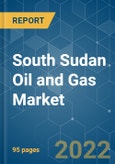The South Sudan oil and gas market is expected to grow at a CAGR of more than 5% during the forecast period. The outbreak of COVID-19 has had negatively impacted the market as the lockdown imposed by the government had influenced the market. Also, the spread of COVID-19 had affected the country's oil production in 2020. For instance, in July 2020, the Ministry of petroleum in South Sudan informed that the country's oil production has dropped by 20,000 barrels per day (b/d) to 170,000 b/d because of the impact of surging coronavirus cases, which has led to disruptions in operations at oil fields. Increasing the production of oil and rising investments into the oil and gas sector are expected to drive the market in the forecast period. However, instability caused by the civil war in the country, along with the high volatility of oil prices, is expected to restraint the market.
Key Highlights
- The downstream sector is expected to increase significantly during the forecast period as increase in the country's oil and gas infrastructure will support the refining market of the country. Also, as being separated from the Sudan, where most of the refineries were situated, it has become one of the government's major initiatives to build a refinery in the country.
- There have been signs of ending the civil war. The civil war was ravaging the country. Peace in the country may lead to much higher growth and may act as an opportunity for the market players,
- Increasing oil production is expected to be the most significant driver of the market in the forecast period as the country depends heavily on the sale of oil and gas for most of its exports to other countries.
Key Market Trends
Downstream Sector to Witness Significant Growth
- The downstream oil industry in South Sudan is an important sector in the country's economy since most of the country's export earnings are spent on imported petroleum products. The South Sudan oil industry is regulated and monitored by the Ministry of Petroleum through the Petroleum Exploration and Production Authority.
- In 2021, to reduce the reliance on imports, the South Sudanese government has started to operate its Bentiu's oil refinery in Unity State, with a capacity to refine 10,000 barrels per day.
- Also, the government has planned to build four more refineries by the end of this decade to increase its refining potential. Trinity Energy was in advanced preparations to start building a 40,000 b/d refinery near the Palouch oil fields in the Upper Nile. It is also reported that one will be based in Sharjah out of four refineries being built.
- South Sudan has a substantial amount of proven oil reserves. In 2020, the country had total proven oil reserves of about 3.5 thousand million barrels. With the proposed and under construction refineries in South Sudan, the crude oil produced can be refined in the country itself to meet the rise in demand for refined petroleum products. Reserve to production ratio in the country in 2020 was 56.1%.
- South Sudan invites international and local investors to participate in a refinery project developed on a PPP basis. Proposed refineries in South Sudan are Akon, with a refining capacity of 50 thousand barrels per day, and Gameza, 100 thousand barrels per day.
- Thus, with such developments the segment is likely to have substantial growth during the study period.
Increasing Production of Oil to Drive the Market
- South Sudan increased its oil production from 148 thousand million barrels/day in 2015 to 170 thousand million barrels/day in 2020. Increased production is expected to generate the growth of the South Sudan oil and gas market during the forecast period.
- In South Sudan, the ongoing civil war and political instability have undermined its ability to increase output to peak production capacity. Low investor confidence and the unfortunate security situation pose severe obstacles to the government's ability to boost crude oil production. However, an end to the conflict can significantly increase the market's growth.
- In September 2020, Sudan and South Sudan signed an agreement to boost oil production between the two countries. The two countries agreed that it is necessary to increase South Sudan's oil production, use Sudan's existing expertise and capabilities, benefit from it, and speed up the process of establishing a coordination office in South Sudan. Thus, the co-operation of the two countries will also support the market's growth during the forecast period.
- Combined Exports of crude oil from South and South Sudan have increased from 128.6 thousand barrels/day in 2016 to 144.4 thousand barrels/day Organization of the Petroleum Exporting Countries (OPEC), as reported by the Organization of the Petroleum Exporting Countries (OPEC) in 2020. Thus, the increase in petroleum exports will boost the country's oil and gas market in the forecast period.
- In January 2021, the Ministry of petroleum in South Sudan informed that oil production in Unity state's Tharjiath oilfield had resumed after nearly eight years of shutdown following the outbreak of civil war in the country in 2013. Tharjiath, also known as Block 5A in southern Unity state, is operated by the Sudd Petroleum Operating Company (SPOC).
- Hence, increasing oil production is expected to drive the growth in the forecast period, with increasing stability expected to attract more investments into the market.
Competitive Landscape
The South Sudan oil and gas market is consolidated. Some of the key players in this market include Nile Petroleum Corporation, Akon Refinery Company Ltd., China National Petroleum Corporation, and Petroliam Nasional Berhad (Petronas) among others.
Additional Benefits:
- The market estimate (ME) sheet in Excel format
- 3 months of analyst support
Table of Contents
Companies Mentioned (Partial List)
A selection of companies mentioned in this report includes, but is not limited to:
- China National Petroleum Corporation
- Nile Petroleum Corporation
- Akon Refinery Company Ltd.
- Petroliam Nasional Berhad (Petronas)
Methodology

LOADING...










